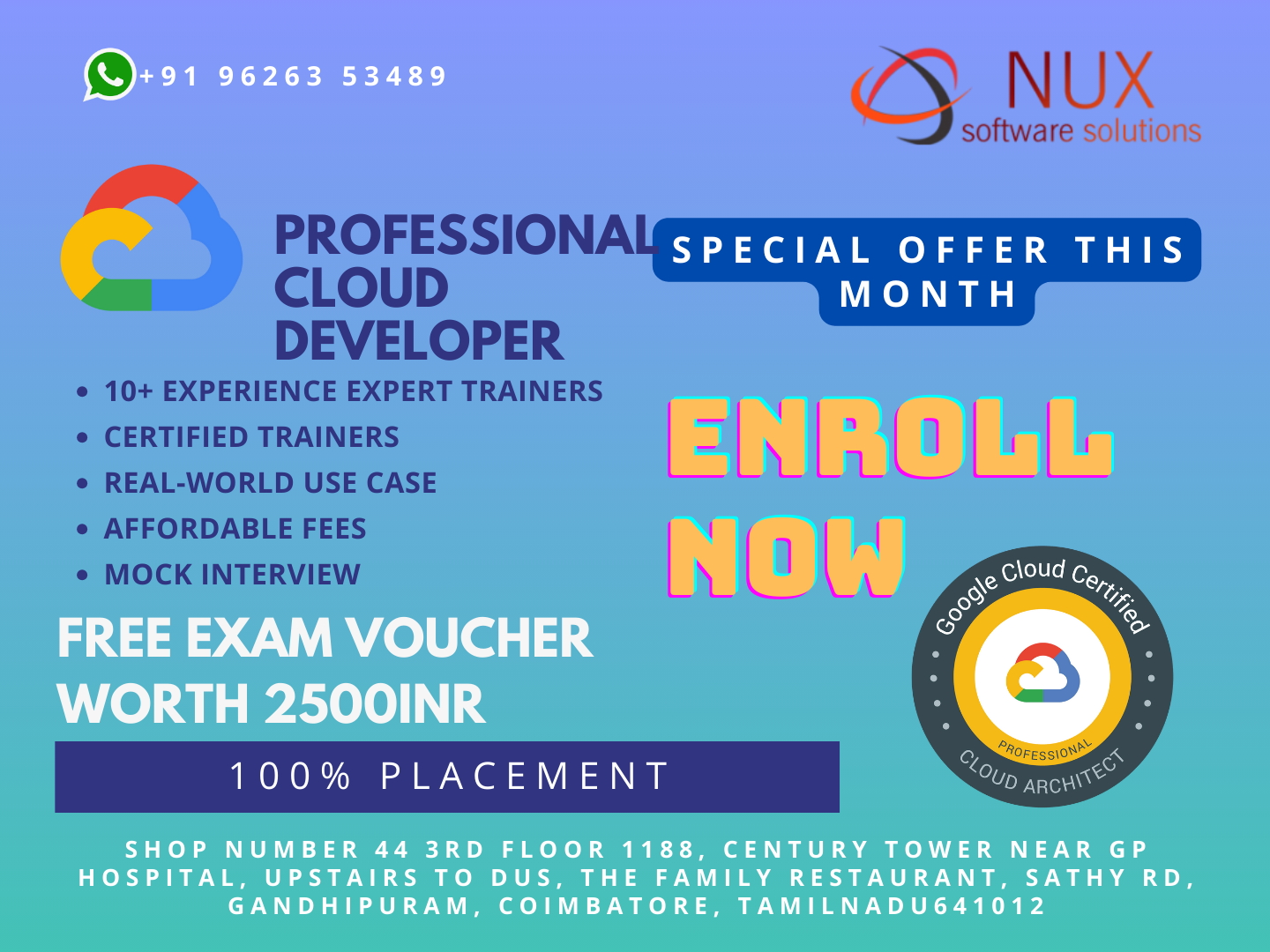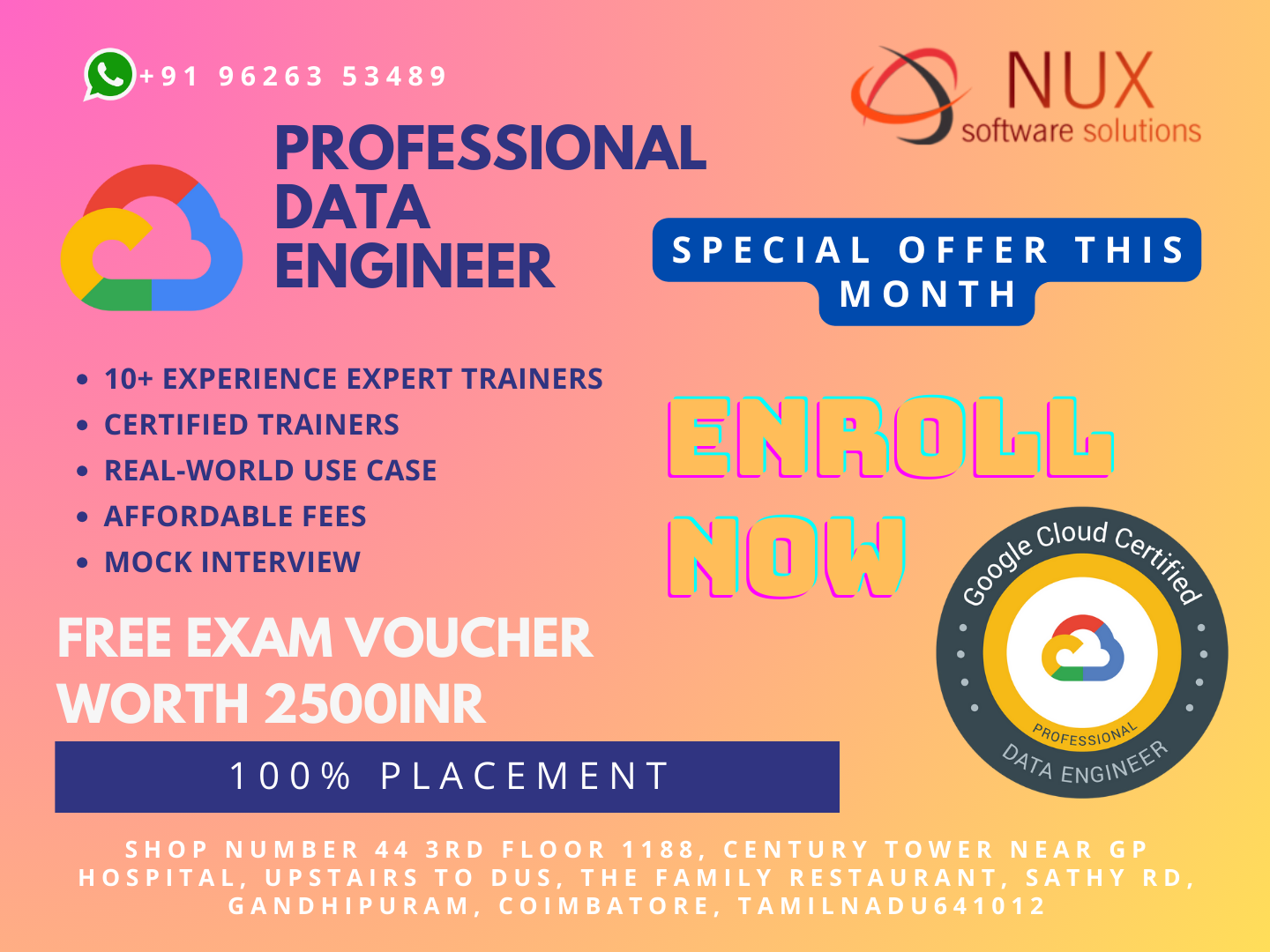Professional Cloud Architect


Best Professional Cloud Architect Training Institute in Coimbatore.
Nux software Training & Certification Solutions in Coimbatore is offering top-notch Professional Cloud Architect training courses. With excellent and advanced programs, industry-expert trainers, and a conducive training center environment, it’s evident that they prioritize providing a high-quality learning experience. The accessibility of labs 24/7 from anywhere adds to the convenience and flexibility of the training.
The presence of international expert trainers with real-time industry experience enhances the overall educational value. The emphasis on innovative learning methods and flexibility in training programs demonstrates an understanding of individual needs and career aspirations. It seems like an ideal place for professional, individual, corporate, live project, and industrial training, promising significant career growth
It’s impressive to note that the Professional Cloud Architect certification has earned recognition as one of the top-paying IT certifications by Global Knowledge. This program not only equips individuals with the skills essential for progressing in their careers as professional cloud architects but also offers recommended training to aid in preparation for the industry-recognized Google Cloud Professional Cloud Architect certification. This dual focus on skill development and certification preparation underscores the program’s commitment to providing a comprehensive and valuable learning experience.
The Professional Cloud Architect certification offers a unique opportunity to deploy solution elements, encompassing infrastructure components like networks, systems, and application services. The hands-on Qwiklabs projects provide a real-world experience, allowing individuals to gain practical insights into implementing and managing various aspects of cloud solutions. This practical approach ensures that certification holders not only possess theoretical knowledge but also have hands-on expertise in deploying and managing essential elements in cloud architecture.
Upon successfully completing the program, you’ll receive a certificate of completion. This certification serves as a valuable credential to share with your professional network and potential employers, showcasing your proficiency and achievement in the Professional Cloud Architect program. It’s a tangible acknowledgment of the skills and knowledge you’ve gained throughout the certification process.
Becoming Google Cloud certified and showcasing your expertise in cloud architecture and Google Cloud Platform involves registering for and successfully passing the official Google Cloud certification exam. For more details on registration and additional resources to support your preparation, you can find comprehensive information at NexTech IT Training & Certification Solutions. They offer the necessary guidance and resources to help you navigate the certification process and demonstrate your proficiency in designing, developing, and managing solutions to drive business objectives.
Course Syllabus
Professional Cloud Architect Syllabus
1. Designing a solution infrastructure that meets business requirements. Considerations include:
Business use cases and product strategy
Cost optimization
Supporting the application design
Integration with external systems
Movement of data
Design decision trade-offs
Build, buy, modify, or deprecate
Success measurements (e.g., key performance indicators [KPI], return on investment [ROI], metrics)
Compliance and observability
2. Designing a solution infrastructure that meets technical requirements. Considerations include:
High availability and failover design
Elasticity of cloud resources with respect to quotas and limits
Scalability to meet growth requirements
Performance and latency
3. Designing network, storage, and compute resources. Considerations include:
Integration with on-premises/multicloud environments
Cloud-native networking (VPC, peering, firewalls, container networking)
Choosing data processing technologies
Choosing appropriate storage types (e.g., object, file, databases)
Choosing compute resources (e.g., preemptible, custom machine type, specialized workload)
Mapping compute needs to platform products
4. Creating a migration plan (i.e., documents and architectural diagrams). Considerations include:
Integrating solutions with existing systems
Migrating systems and data to support the solution
Software license mapping
Network planning
Testing and proofs of concept
Dependency management planning
5. Envisioning future solution improvements. Considerations include:
Cloud and technology improvements
Evolution of business needs
Evangelism and advocacy
1. Configuring network topologies. Considerations include:
Extending to on-premises environments (hybrid networking)
Extending to a multicloud environment that may include Google Cloud to Google Cloud communication
Security protection (e.g. intrusion protection, access control, firewalls)
2. Configuring individual storage systems. Considerations include:
Data storage allocation
Data processing/compute provisioning
Security and access management
Network configuration for data transfer and latency
Data retention and data life cycle management
Data growth planning
3. Configuring compute systems. Considerations include:
Compute resource provisioning
Compute volatility configuration (preemptible vs. standard)
Network configuration for compute resources (Google Compute Engine, Google Kubernetes Engine, serverless networking)
Infrastructure orchestration, resource configuration, and patch management
Container orchestration
1. Designing for security. Considerations include:
Identity and access management (IAM)
Resource hierarchy (organizations, folders, projects)
Data security (key management, encryption, secret management)
Separation of duties (SoD)
Security controls (e.g., auditing, VPC Service Controls, context aware access, organization policy)
Managing customer-managed encryption keys with Cloud Key Management Service
Remote access
2. Designing for compliance. Considerations include:
Legislation (e.g., health record privacy, children’s privacy, data privacy, and ownership)
Commercial (e.g., sensitive data such as credit card information handling, personally identifiable information [PII])
Industry certifications (e.g., SOC 2)
Audits (including logs)
1. Analyzing and defining technical processes. Considerations include:
Software development life cycle (SDLC)
Continuous integration / continuous deployment
Troubleshooting / root cause analysis best practices
Testing and validation of software and infrastructure
Service catalog and provisioning
Business continuity and disaster recovery
2. Analyzing and defining business processes. Considerations include:
Stakeholder management (e.g. influencing and facilitation)
Change management
Team assessment / skills readiness
Decision-making processes
Customer success management
Cost optimization / resource optimization (capex / opex)
3. Developing procedures to ensure reliability of solutions in production (e.g., chaos engineering, penetration testing)
1. Advising development/operation teams to ensure successful deployment of the solution. Considerations include:
Application development
API best practices
Testing frameworks (load/unit/integration)
Data and system migration and management tooling
2. Interacting with Google Cloud programmatically. Considerations include:
Google Cloud Shell
Google Cloud SDK (gcloud, gsutil and bq)
Cloud Emulators (e.g. Cloud Bigtable, Datastore, Spanner, Pub/Sub, Firestore)
1. Monitoring/logging/profiling/alerting solution
2. Deployment and release management
3. Assisting with the support of deployed solutions
4. Evaluating quality control measures


